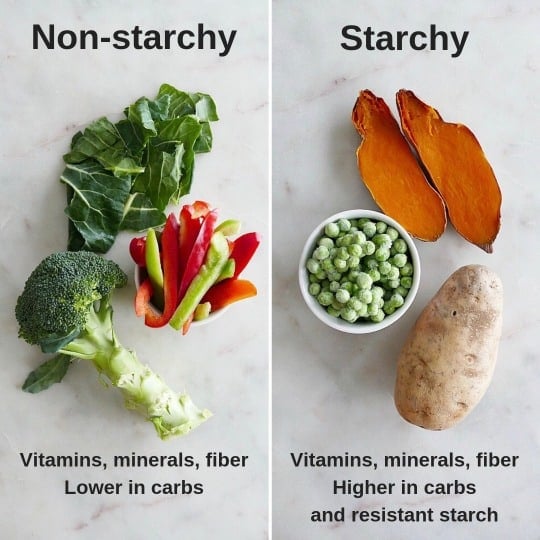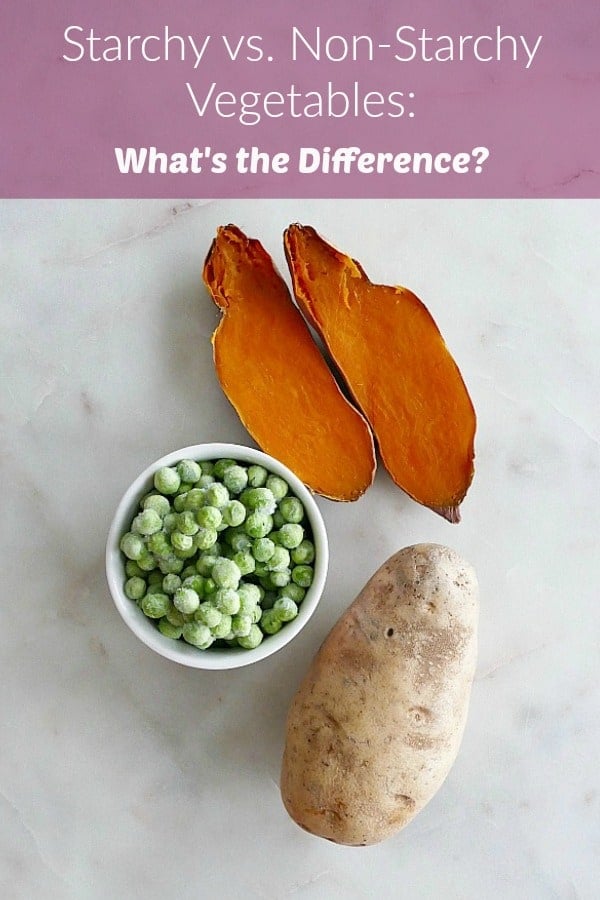Learn about the differences between starchy and non-starchy vegetables in this breakdown of their nutrition, benefits, and more!

One of the most tried and true pieces of nutrition advice is “eat your veggies!” Vegetables are some of the most nutrient-dense foods that exist. They’re loaded with vitamins, minerals, and fiber, and provide plant compounds that may prevent disease (1, 2).
While all veggies contain some amount of micronutrients, carbs, and fiber, every vegetable has a different nutrition composition, and some veggies have more starch than others. In fact, vegetables are typically divided into two categories: starchy and non-starchy.
But what are the main differences between the two types of vegetables anyway?
Starchy vs. Non-Starchy Vegetables
Vegetables that contain relatively small amounts of starch, a type of carbohydrate, are considered non-starchy vegetables. These include:
- Asparagus
- Broccoli
- Brussels Sprouts
- Carrots
- Cauliflower
- Celery
- Green Beans
- Leafy greens (spinach, kale, arugula, collards, etc.)
- Mushrooms
- Onions
- Peppers
- Radishes
- Summer squash

On the other hand, veggies with more starch are called starchy vegetables. Popular starchy veggies include:
- Corn
- Most winter squash (acorn, butternut)
- Parsnips
- Peas
- Sweet Potatoes
- Potatoes

Carbohydrates in Vegetables
Since starchy vegetables have more starch (I mean, it is in their name after all), they have more carbohydrates than their non-starchy counterparts. They therefore may increase blood sugar more than non-starchy vegetables and usually contain more calories.
Here are some popular non-starchy veggies and their approximate carbohydrates per 1 cup (3):
- Broccoli: 6 grams
- Bell pepper: 7 grams
- Cauliflower: 5 grams
- Green beans: 7 grams
- Mushrooms: 2 grams
Here are some common starchy veggies and their approximate carbohydrates per 1 cup (3):
- Acorn squash: 15 grams
- Butternut squash: 16 grams
- Corn: 29 grams
- Peas: 21 grams
- Sweet potatoes: 27 grams
Benefits of Starchy Vegetables
Due to their higher carb content, starchy vegetables sometimes get unfairly demonized. Some people even go so far as to avoid starchy vegetables in fear that they will lead to weight gain. Earlier this year, I saw a headline for “vegetables to avoid if you want to lose weight” and I cringed!
In reality, starchy vegetables offer complex carbohydrates and fiber that help boost energy, increase satiety, and stabilize blood sugars, especially if they are eaten in combination with foods that contain protein or healthy fats. They are incredibly satisfying and some of the best foods you can eat to meet your carbohydrate needs.
Sure, eating too much starch from foods like pastas, breads, and cookies made from white flour is probably not the best for your health. If these foods make up the majority of your meals and you are eating too many calories because of it, then you might see some weight gain. But do starchy vegetables have the same effect? No, especially if you aren’t eating large portions of them at every meal in addition to refined carbs.
Eating a varied diet and trying to incorporate all three macronutrients – proteins, fats, and carbs – at meals will help you meet your nutrition needs, feel energized, and decrease your consumption of foods that offer little to no nutrition.
Lastly, some starchy vegetables contain resistant starch, a type of starch that does not get fully digested and acts in a way similar to fiber in the body. Studies show that resistant starch may feed beneficial bacteria in the gut, promote good digestion, and improve blood sugar control (4).
Starchy vegetables with resistant starch include peas and cooked then cooled potatoes.
When Portions Matter
There are times when a low (or lower) carbohydrate diet is appropriate and may provide health benefits.
Studies show that reducing carb intake may help with weight loss and blood sugar control, especially in people with diabetes (5). Decreasing carb intake and increasing fat consumption to maintain a ketogenic diet may also have benefits, particularly for children with epilepsy (6).
If you have been advised to decrease your overall intake of carbohydrates to help with a specific condition, then starchy vegetables may not always fit into your diet.
Recipes with Starchy Vegetables
However, if you want to incorporate more starchy vegetables into your meals, I have several recipes for you to try!
Eating starchy vegetables in place of highly processed or refined carbs, such as those found in white flours, pastries, candies, and soda, can help satisfy your desire and need for carbs in a more nutritious way.
For a complete meal, add some protein-rich foods, non-starchy veggies, and healthy fats.
Check out these recipes with starchy veggies to get you started:
- Savory Roasted Root Vegetables
- Slow Cooker Butternut Squash Brown Rice Risotto
- Lemon Rosemary Roasted Fingerling Potatoes
- Lentil Stuffed Acorn Squash
Like what you learned? Pin this article to share with your friends!






Nannette Collins
Good morning
I came across to this post. Starchy should be 1/4
Non – starchy 1/2 ?
Lizzie Streit, MS, RDN
Hi Nannette, I’m not sure what your question is asking. Can you clarify?
Meghna Rao
What are your sources for the carbohydrates per 1 cup values listed herein?\
Trying to get a sense of where these values come from
Lizzie
Hi Meghna, I get nutrition information from the USDA Food Database or FoodData Central: https://fdc.nal.usda.gov/index.html and https://ndb.nal.usda.gov/ndb/search/. Let me know if you have any other questions!